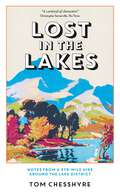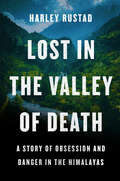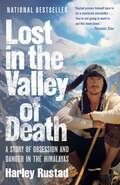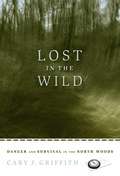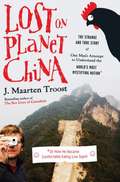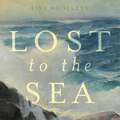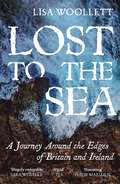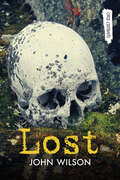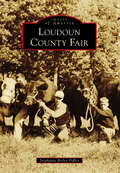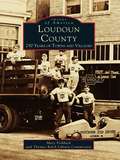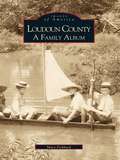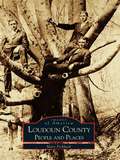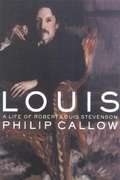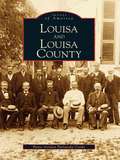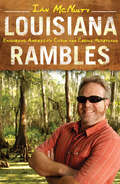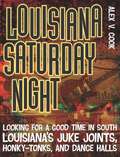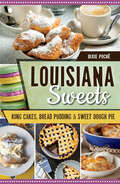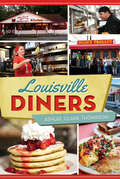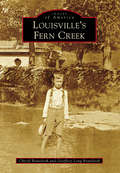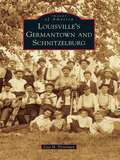- Table View
- List View
Lost in the Lakes: Notes from a 379-Mile Hike Around the Lake District
by Tom ChesshyreJoin travel writer Tom Chesshyre for a lakeland adventure like no other. Explore towering mountains, wide-open valleys and magnificent lakes - stopping off at a cosy inn or two along the way - on a 379-mile hike around the Lake DistrictFrom Penrith and back, via Keswick, Cockermouth, Coniston, Grasmere and Windermere, plus many places in between, Tom Chesshyre puts on his walking boots and sets forth in a "big wobbly circle" around the Lakes, drawn onwards by the dramatic scenery that attracts more than 19 million visitors each year.Across landscape that so inspired the Romantic poets, he takes in remote parts of the parkland that many tourists miss - enjoying encounters aplenty with farmers, fell runners and fellow hikers, while staying in shepherds' huts, bothies and old climbers' hotels along the way, and even going for a (chilly) dip in Derwentwater.This is the Lake District seen from its walking paths - with just a backpack, an open mind... and a spring in the step.
Lost in the Valley of Death: A Story of Obsession and Danger in the Himalayas
by Harley RustadIn the vein of Jon Krakauer's Into the Wild, a riveting work of narrative nonfiction centering on the unsolved disappearance of an American backpacker in India—one of at least two dozen tourists who have met a similar fate in the remote and storied Parvati Valley.For centuries, India has enthralled westerners looking for an exotic getaway, a brief immersion in yoga and meditation, or in rare cases, a true pilgrimage to find spiritual revelation. Justin Alexander Shetler, an inveterate traveler trained in wilderness survival, was one such seeker.In his early thirties Justin Alexander Shetler, quit his job at a tech startup and set out on a global journey: across the United States by motorcycle, then down to South America, and on to the Philippines, Thailand, and Nepal, in search of authentic experiences and meaningful encounters, while also documenting his travels on Instagram. His enigmatic character and magnetic personality gained him a devoted following who lived vicariously through his adventures. But the ever restless explorer was driven to pursue ever greater challenges, and greater risks, in what had become a personal quest—his own hero’s journey.In 2016, he made his way to the Parvati Valley, a remote and rugged corner of the Indian Himalayas steeped in mystical tradition yet shrouded in darkness and danger. There, he spent weeks studying under the guidance of a sadhu, an Indian holy man, living and meditating in a cave. At the end of August, accompanied by the sadhu, he set off on a “spiritual journey” to a holy lake—a journey from which he would never return.Lost in the Valley of Death is about one man’s search to find himself, in a country where for many westerners the path to spiritual enlightenment can prove fraught, even treacherous. But it is also a story about all of us and the ways, sometimes extreme, we seek fulfillment in life.Lost in the Valley of Death includes 16 pages of color photographs.
Lost in the Valley of Death: A Story of Obsession and Danger in the Himalayas
by Harley RustadIn the vein of Jon Krakauer's Into the Wild, a riveting work of narrative nonfiction centering on the unsolved disappearance of an American backpacker in India—one of at least two dozen tourists who have met a similar fate in the remote and storied Parvati Valley.For centuries, India has enthralled Westerners looking for an exotic getaway, a brief immersion in yoga and meditation, or, in rare cases, a true pilgrimage to find spiritual revelation. Justin Alexander Shetler, an inveterate traveler trained in wilderness survival, was one such seeker. In his early thirties, Justin quit his job at a tech startup and set out on a global journey—across the United States by motorcycle, then down to South America, and on to the Philippines, Thailand, and Nepal—in search of authentic experiences and meaningful encounters while documenting his travels on Instagram. His enigmatic character and magnetic personality gained him a devoted following who lived vicariously through his adventures. But the ever-restless explorer was driven to seek out ever-greater extremes, and greater risks, in what had become a personal quest—his own hero&’s journey. In 2016, he made his way to the Parvati Valley, a remote and rugged corner of the Indian Himalayas steeped in mystical tradition and shrouded in darkness and danger. There he spent weeks studying under the guidance of a sadhu, an Indian holy man, living and meditating in a cave. At the end of August, accompanied by the sadhu, he set off on a spiritual journey to a holy lake—one from which he would never return. Lost in the Valley of Death is about one man&’s search to find himself, in a country where, for many Westerners, the path to spiritual enlightenment can prove fraught, even treacherous. But it is also a story about all of us and the ways, sometimes extreme, we seek fulfillment in life.
Lost in the Wild: Danger and Survival in the North Woods
by Cary J. GriffithIn the wilderness, one false step can make the difference between a delightful respite and a brush with death. On a beautiful summer afternoon in 1998, Dan Stephens, a 22-year-old canoeist, was leading a trip deep into Ontario's Quetico Provincial Park. He stepped into a gap among cedar trees to look for the next portage -- and did not return. More than four hours later, Dan awakened with a lump on his head from a fall and stumbled deeper into the woods, confused. Three years later, Jason Rasmussen, a third-year medical student who loved the forest's solitude, walked alone into the Boundary Waters Canoe Area Wilderness on a crisp fall day. After a two-day trek into a remote area of the woods, he stepped away from his campsite and made a series of seemingly trivial mistakes that left him separated from his supplies, wet, and lost, as cold darkness fell. Enduring days without food or shelter, these men faced the full harsh force of wilderness, the place that they had sought out for tranquil refuge from city life. Lost in the Wild takes readers with them as they enter realms of pain, fear, and courage, as they suffer dizzying confusion and unending frustration, and as they overcome seemingly insurmountable hurdles in a race to survive.
Lost on Planet China: The Strange and True Story of One Man's Attempt to Understand the World's Most Mystifying Nation or How He Became Comfortable Eating Live Squid
by J. Maarten TroostThe bestselling author of The Sex Lives of Cannibals returns with a sharply observed, hilarious account of his adventures in China--a complex, fascinating country with enough dangers and delicacies to keep him, and readers, endlessly entertained. Maarten Troost has charmed legions of readers with his laugh-out-loud tales of wandering the remote islands of the South Pacific. When the travel bug hit again, he decided to go big-time, taking on the world's most populous and intriguing nation. In Lost on Planet China, Troost escorts readers on a rollicking journey through the new beating heart of the modern world, from the megalopolises of Beijing and Shanghai to the Gobi Desert and the hinterlands of Tibet. Lost on Planet China finds Troost dodging deadly drivers in Shanghai; eating Yak in Tibet; deciphering restaurant menus (offering local favorites such as Cattle Penis with Garlic); visiting with Chairman Mao (still dead, very orange); and hiking (with 80,000 other people) up Tai Shan, China's most revered mountain. But in addition to his trademark gonzo adventures, the book also delivers a telling look at a vast and complex country on the brink of transformation that will soon shape the way we all work, live, and think. As Troost shows, while we may be familiar with Yao Ming or dim sum or the cheap, plastic products that line the shelves of every store, the real China remains a world--indeed, a planet--unto itself. Maarten Troost brings China to life as you've never seen it before, and his insightful, rip-roaringly funny narrative proves that once again he is one of the most entertaining and insightful armchair travel companions around.
Lost to the Sea: A Journey Round the Edges of Britain and Ireland
by Lisa Woollett'An immersive and lyrically personal journey through deep-time and modern tides' RAYNOR WINN'Wondrous, elegant and haunting, Lost to the Sea is a fascinating alternative history of the fractured, flooded and eroded edges of Britain and Ireland' PHILIP HOAREMedieval kingdoms. Notorious pirate towns. Drowned churches. Crocodile-infested swamps.On a series of coastal walks, Lisa Woollett takes us on an illuminating journey, bringing to life the places where mythology and reality meet at the very edges of Britain and Ireland.From Bronze Age settlements on the Isles of Scilly and submerged prehistoric forests in Wales, to a Victorian amusement park on the Isle of Wight and castles in the air off County Clare, Lisa draws together archaeology, meetings with locals and tales from folklore to reveal how the sea has forged, shaped and often overwhelmed these landscapes and communities.Lost to the Sea is an exhilarating voyage around the ever-shifting shores of the British Isles, and a haunting ode to our profound relationship with the sea.'A hugely enjoyable mosaic of history, myth and imagination' SARA WHEELER'Beautifully written and researched . . . I was immediately tempted to head out in search of lost lands' WYL MENMUIR
Lost to the Sea: A Journey Round the Edges of Britain and Ireland
by Lisa Woollett'An immersive and lyrically personal journey through deep-time and modern tides' RAYNOR WINN'Wondrous, elegant and haunting, Lost to the Sea is a fascinating alternative history of the fractured, flooded and eroded edges of Britain and Ireland' PHILIP HOAREMedieval kingdoms. Notorious pirate towns. Drowned churches. Crocodile-infested swamps.On a series of coastal walks, Lisa Woollett takes us on an illuminating journey, bringing to life the places where mythology and reality meet at the very edges of Britain and Ireland.From Bronze Age settlements on the Isles of Scilly and submerged prehistoric forests in Wales, to a Victorian amusement park on the Isle of Wight and castles in the air off County Clare, Lisa draws together archaeology, meetings with locals and tales from folklore to reveal how the sea has forged, shaped and often overwhelmed these landscapes and communities.Lost to the Sea is an exhilarating voyage around the ever-shifting shores of the British Isles, and a haunting ode to our profound relationship with the sea.'A hugely enjoyable mosaic of history, myth and imagination' SARA WHEELER'Beautifully written and researched . . . I was immediately tempted to head out in search of lost lands' WYL MENMUIR
Lost: Books V And Vi (Orca Currents)
by John WilsonSam and Annabel are pleased when they are selected to take a cruise to the Arctic. They are thrilled when they learn that the cruise will take them past a site connected to the most famous mystery in Arctic history: the Franklin Expedition. But things on the cruise are not what they seem. When Sam and Annabel make a startling discovery on a small island close to where archaeologists are diving on the wreck of the Erebus, one of the Franklin’s ships, they are confronted by an old enemy. Isolated and outnumbered, how can they possibly save the priceless artifact that may hold the answer to the Franklin mystery? This short novel is a high-interest, low-reading level book for middle-grade readers who are building reading skills, want a quick read or say they don’t like to read! The epub edition of this title is fully accessible.
Loudoun County Fair
by Stephanie Briley FidlerDating back to 1936, the Loudoun County Fair has been a place for the community to celebrate the agriculture of the area. Established for 4-H members to have a fair of their own, the Loudoun County Fair has provided a place, along with volunteers and the support of the community, for the children to exhibit their animals, home economics projects, and produce. After moving from Purcellville to Middleburg and then to Lincoln, the fair found a permanent home in 1956 on donated land in the Clarke's Gap area of Loudoun County. Since the 1957 fair, a livestock auction has been added, an auditorium has been built, and new barns have been erected. Take a step back, slow down, and enjoy the history and beauty of one of Loudoun's longest-running events, the Loudoun County Fair.
Loudoun County: 250 Years of Towns and Villages
by Mary Fishback Thomas Balch Library CommissionLoudoun County, one of Virginia's most charming areas, is truly a picturesque region, balanced with sweeping pastoral landscapes along the Potomac and many lovely small towns and villages. Over the pastseveral hundred years, this county has enjoyed an ethnic-rich past, meaning that many diverse cultures--the American Indian, European, and African--have called this place home. These different civilizations have left an indelible mark on Loudoun County's character and architectural appearance, from traditional churches and shops to the more ornate and lavish homes scattered across the countryside. Fortunately, many of these buildings still stand, serving as fitting reminders to these different people's struggles and lives. In this volume of over 200 photographs, many never before published, you will experience the Loudoun County of yesteryear--a time when wagons and early automobiles competed for space on the same dusty highways, when homes and schools were made of cobblestone and woodframing, and when life seemed, overall, slower and less complicated. This book takes us on a wonderful journey through the county's major towns, such as Leesburg, Hamilton, Hillsboro, Lovettsville, Middleburg, Purcellville, and Round Hill, and to the smaller villages, such as Waterford, Broad Run Farms, and Taylorstown. From the turn of the twentieth century to more contemporary times, you will see your "home county" as you have never seen it before or as you remembered it as a child.
Loudoun County: A Family Album (Images of America)
by Mary FishbackIn the fast-paced world in which we live, the relationships among families and friends continue to be the bonds that hold our complex communities together. Located in the flourishing region of Northern Virginia, Loudoun County has experienced significant growth in recent years, but it is those essential ties, the determined character of the region's first inhabitants, and the importance ofheritage to the generations that have followed that have truly shaped the area's singular personality. Documented in the contents of leather-bound picturealbums, cardboard boxes, and dusty attic trunks, the most touching stories of the region are found in the collected everyday memories of its people. Loudoun County: A Family Album takes readers on an intimate tour of the county's major towns and small villages through the eyes of the people who lived and worked in these communities. From candid snapshots taken on family vacations and school outings to early photographs of the town's first farmers and entrepreneurs, this volume of over 200 vintage images captures the everyday lives of the citizens who have persevered to make their home the beautiful, diverse, and charming place it has become. Showcasing the work of both Winslow Williams, one of Loudoun's best and most prolific photographers, as well as the efforts of doting parents and grandparents, friendly neighbors, and enthusiastic playmates from throughout the area, this book provides a one-of-a-kind glimpse at the county from a uniquely personal perspective.
Loudoun County: People and Places
by Mary FishbackAlthough geography plays a significant role in a place's identity, it is the people and their stories that make an area special. Loudoun County is one such place, a county known for its charm and uniquepersonality. Over the past 250 years, the county has drawn a truly eclectic population from across the world, and these different immigrant groups have shaped the county's history with their churches, schools, and businesses--all still clearly visible into the twenty-first century. Loudoun County: People and Places highlights the everyday life of itscitizens throughout the county, capturing in word and image the local flavor of Leesburg and the county's many historic towns and villages. Possessing a strong religious presence, Loudoun County is dotted with many old churches, representing a wide network of beliefs and faiths,and this volume takes readers on an extraordinary visual tour showcasing their beautiful exteriors and diverse architectural styles. Throughout the rest of the work, readers will encounter scenes of forgotten one-room schoolhouses, posed snapshots of early faculty members and students, and different views around the county that capture early businesses, local celebrations, and famous homes. This book also features a chapter on the photographs of Winslow Williams, a prolific local studio photographer whose work has preserved many scenes and familiar facesaround the county.
Louis: A Life of Robert Louis Stevenson
by Philip CallowThere are many Stevensons behind the initials RLS, but the one that has endeared him to readers for so long is surely the fighter, battling to stay alive. Jorge Luis Borges described his brief life as courageous and heroic. In Philip Callow s absorbing new biography, one can see why. Doctors, called repeatedly to what should have been his deathbed, would find a scarecrow, twitching and alive. A sickly child, Louis became in turn a bohemian dandy, a literary gypsy traipsing through the mountains of France with a donkey, and at twenty-eight the lover of an American woman ten years his senior, the fabulous Fanny. He escaped his Scottish town, his family, his friends who had mapped out a literary career for him in London, and instead went chaotically across the Atlantic and overland to California in poverty and despair to reach his beloved, whereupon he escaped into marriage and committed himself to being a nomad. He sailed the Pacific and dreamed of being an explorer; his restlessness was Victorian. With the power of a novelist and the grace of a poet (of which he is both), Philip Callow captures this great writer and his many contradictions. He was a born exile longing for home; a northerner who thrived on tropic sunshine; a near atheist who organized Sunday services for his Samoan workers. He has been called Scotland's finest writer of English prose, a more economical Walter Scott. As an essayist he equaled Hazlitt. In emotional crises he wept openly, to the embarrassment of his wife. His feelings are always his reasons, said Henry James, and caught in a sentence the secret of Stevenson s popularity as one of the last of the classic storytellers. Louis brings him alive. With 8 pages of black-and-white photographs. "
Louisa and Louisa County (Images of America)
by Pattie Gordon CookeFilled with local stories and anecdotes and containing an impressive range of photographs-from snapshots of veterans of the War Between the States to high school class pictures from the 1950s; from early images of the resort area to photographs documenting recent changes to Louisa-this new book will earn a lasting place on area bookshelves and will be handed down from generation to generation for years to come. Louisa and Louisa County will be enjoyed by older folk as a trip down memory lane, and appreciated by younger generations as a glimpse of an era when life was harder, but perhaps simpler. Also a valuable source of information for newcomers to the area, this powerful work serves to remind us of the importance of understanding our past and preserving our heritage in our march toward the twenty-first century.
Louisiana Rambles: Exploring America's Cajun and Creole Heartland
by Ian McNultyAfter Hurricane Katrina laid bare the fragility and environmental peril of South Louisiana, author Ian McNulty set out on a series of daytrips to delve into the area's diverse cultural landscapes. He explored communities staked up and down the Mississippi River, nestled into the teeming bayous, braced along the edge of the Gulf, and planted out on the golden prairie stretching to the west. Louisiana Rambles is his richly evocative guide to those journeys. McNulty delivers an inimitable take on Cajun and Creole Louisiana—the siren call of zydeco dance halls pulsing in the country darkness; of crawfish “boiling points” and traditional country smokehouses; of Cajun jam sessions, where even wallflowers are compelled to dance; of equine gambits in the cradle of jockeys; and of fishing trips where anyone can land impressive catches. In South Louisiana, distilled European heritage, the African American experience, and modern southern exuberance mix with tumultuous history and fantastically fecund natural environments. The territories McNulty opens to the reader are arguably the nation's most exotic and culturally distinct destinations. McNulty quests for the heart of these places and people. Much more than a travel guide or collection of travel narratives, Louisiana Rambles is a seasoned writer's witness to an epic locale that is very often joyous, sometimes heartbreaking, and always vital and stimulating. An extensive, chapter-by-chapter appendix filled with travel tips and notes from the road (or the bayou) will let visitors explore well beyond the beaten tourist paths and help Louisiana residents appreciate their own terrain in a new light.
Louisiana Saturday Night: Looking for a Good Time in South Louisiana's Juke Joints, Honky-Tonks, and Dance Halls (Southern Messenger Poets)
by Alex V. CookFrom backwoods bars and small-town dives to swampside dance halls and converted clapboard barns, Louisiana Saturday Night offers an anecdotal history and experiential guidebook to some of the Gumbo State's most unique blues, Cajun, and zydeco clubs. Music critic Alex V. Cook uncovers south Louisiana's wellspring of musical tradition, showing us that indigenous music exists not as an artifact to be salvaged by preservationists, but serves as a living, breathing, singing, laughing, and crying part of Louisiana culture. Louisiana Saturday Night takes the reader to both offbeat and traditional venues in and around Baton Rouge, Cajun country, and New Orleans, where we hear the distinctive voices of musicians, patrons, and owners -- like Teddy Johnson, born in the house that now serves as Teddy's Juke Joint. Along the way, Cook ruminates on the cultural importance of the people and places he encounters, and shows their critical role in keeping Louisiana's unique music alive. A map, a journal, a snapshot of what goes on in the little shacks off main roads, Louisiana Saturday Night provides an indispensable and entertaining companion for those in pursuit of Louisiana's quirky and varied nightlife.
Louisiana Sweets: King Cakes, Bread Pudding, & Sweet Dough Pie (American Palate Ser.)
by Dixie PochéExplore the recipes and history behind an array of sweet treats from the Sugar State with help from the author of Classic Eateries of Cajun Country.Louisiana is famous for its culinary delights, and the state&’s rich medley of treats and confections proves its sweet tooth. Creative bakers improvised traditional recipes during days of rationing to create gateau de sirop (syrup cake) and bread pudding. Early customers of Lea&’s Lunchroom&’s pies in central Louisiana included outlaws Bonnie and Clyde, who dropped by while they were on the run. During the 1950s, singers Hank Williams Sr. and Elvis Presley hung out at Shreveport&’s Southern Maid Donuts after performing at the popular Louisiana Hayride country music broadcast. Author Dixie Poché dives into the recipes and history behind such beloved regional specialties as Mardi Gras king cake, flaming Bananas Foster, Cajun Country&’s pain perdu and many more.&“Desserts Past, Present, and Future are the stars of Dixie Poché&’s new book, Louisiana Sweets: King Cakes, Bread Pudding, and Sweet Dough Pie. The Lafayette-based travel writer gets rather Dickensian (but trade that tacky soot for powdered sugar) as she lays outs a picture of the state&’s love affair with sweets through history, anecdotes, recipes, restaurant profiles, and more.&” —Country Roads Magazine
Louisville Diners (American Palate)
by Ashlee Clark ThompsonLouisville boasts many award-winning fine dining restaurants, but long before Derby City mastered upscale cuisine, it perfected the diner. Explore Louisville's tasty offerings with local food writer Ashlee Clark Thompson as she surveys the city's impressive variety of greasy spoons from the Highlands to the West End and everywhere in between. Enjoy home cooking done right at Shirley Mae's Café and Bar, breakfast at Barbara Lee's Kitchen, lunch to go at Ollie's Trolley and so much more. Packed with insightful interviews and helpful tips that only a local can provide, Louisville Diners is a delectable look into the best the city has to offer.
Louisville's Fern Creek
by Geoffrey Long Brandreth Cheryl BrandrethLocated in southeastern Jefferson County, Louisville's Fern Creek community was settled in the 1780s with land grants given by Virginia for military service. The construction of the Louisville-Bardstown Turnpike encouraged Fern Creek's growth as farmers settled the land along the route. Originally known as Stringtown for the appearance of the houses that sprang up along Bardstown Pike, Fern Creek is named after the creek that meanders through the area. Due to the abundant sources of water throughout the southeastern portion of Jefferson County, several mills operated in the area, most notably in Buechel, on Cedar Creek, and on Floyd's Fork. The erection of mills provided early settlers the means to grind corn and wheat. Originally an agricultural community of fields, orchards, and stables, Fern Creek established the Farmers and Fruit Growers Association in 1880 and the Jefferson County Fair Company, which operated at the Fern Creek Fairgrounds until 1928.
Louisville's Germantown and Schnitzelburg (Images of America)
by Lisa M. PistermanBelieved to have been named for the citizens who settled the area as early as the 1840s, Germantown and Schnitzelburg are located just east of downtown Louisville. The first parcels purchased and settled were part of the 1,000-acre land grant that was awarded to Col. Arthur Campbell in 1790 for his service to Virginia in the Indian Wars. Spanning more than 160 years of growth, the area developed from farms and dairies in the 1850s, to the industrialization of the 1880s, and then the halcyon era of the 1950s as a safe haven of family, community, and church. Remarkable historic landmarks include a Victorian-era cotton mill, DuPont Manual High School's football stadium, and the eclectic collection of residential architecture classified as "shotgun" and "camelback." Numerous neighborhood taverns and bakeries are both historic landmarks and popular eateries in this community. Look inside and enjoy the history and beauty of a bygone era and the development of a thriving community.
Love From Joy (A Girl Called Joy #2)
by Jenny ValentineFor readers aged 9+ comes the second book in a sparkling new series about family, friends and finding the joy in life! From the mind of Guardian award-winning author Jenny Valentine, this is the perfect series for fans of Jacqueline Wilson, Cath Howe and Lara Williamson! Hi! My name is Joy Applebloom and I'm ten years old. People say I am a &‘glass half full&’ kind of person, which basically means I see the good in everything. And right now I&’m going to need all my powers of positive thinking to fix a really tricky situation . . . My new best friend Benny just hasn&’t been himself lately. I have to find out what&’s going on and bring back Benny&’s special smile for good…A heart-warming and positive story about family, friends and the importance of kindness with gorgeous illustrations from Claire Lefevre. Praise for A Girl Called Joy:'This book [. . .] is a delight for its warmth and humour, but principally because the writing is alive and stunning.&’ The Sunday Times Children's Book of the Week.
Love From Venice: A golden summer on the Grand Canal
by Gill JohnsonIn the summer of 1957, rebelling against her family and anxious to impress an admirer who had moved to Paris, Gill Johnson, aged twenty-five, gave up her comfortable job at the National Gallery in London and travelled to Venice to take up a job teaching English to an aristocratic Italian family. Love from Venice is her vivid evocation of that summer, the last hurrah of the European Grand Tour, when the international jet set lit upon the city for their fun. Drawing on letters that she wrote to David Ross, her admirer and correspondent, and to her parents in London, Johnson describes her life as she flits from palazzo to Lido to palazzo. Absorbed into the social whirl of the super-rich, how do her feelings for her love begin to change?This is a moving and witty memoir of a young woman coming to terms with her own feelings and destiny, and learning about different aspects of love from the people she meets, all set in high-season Venice in a halcyon age.
Love From Venice: A golden summer on the Grand Canal
by Gill JohnsonA charming, funny and glamorous memoir and love-story, about a summer in 1957 in Venice, working for an aristocratic Italian family.In the summer of 1957, anxious to impress an admirer who had moved to Paris, while rebelling against her family, Gill Johnson, aged twenty-five, gave up her comfortable job at the National Gallery in London and travelled to Venice to take up a job teaching English to an aristocratic Italian family. Love from Venice is her vivid evocation of that summer, the last hurrah of the European Grand Tour, when the international jet set lit upon the city for their fun. Johnson describes (including through original letters written to her love in Paris) her life flitting from palazzo to Lido to palazzo, and how her feelings for him grow, while she becomes absorbed into the social whirl of the super-rich. It is a moving and witty memoir of a young woman coming to terms with her own feelings and destiny, and learning about different aspects of love from the people she meets, all set in high-season Venice in a halcyon time. By the end, Johnson discovers if the scabrous excesses of fabulous wealth can divert the course of true love.(P)2024 Hodder & Stoughton Limited
Love From Venice: A golden summer on the Grand Canal
by Gill JohnsonIn the summer of 1957, rebelling against her family and anxious to impress an admirer who had moved to Paris, Gill Johnson, aged twenty-five, gave up her comfortable job at the National Gallery in London and travelled to Venice to take up a job teaching English to an aristocratic Italian family. Love from Venice is her vivid evocation of that summer, the last hurrah of the European Grand Tour, when the international jet set lit upon the city for their fun. Drawing on letters that she wrote to David Ross, her admirer and correspondent, and to her parents in London, Johnson describes her life as she flits from palazzo to Lido to palazzo. Absorbed into the social whirl of the super-rich, how do her feelings for her love begin to change?This is a moving and witty memoir of a young woman coming to terms with her own feelings and destiny, and learning about different aspects of love from the people she meets, all set in high-season Venice in a halcyon age.
Love Is: A Yearlong Experiment of Living Out 1 Corinthians 13 Love
by Kim SorrelleEngage with a love that transcends social experiments and leads to a radically transformed lifeEven non-Christians are familiar with the Love Chapter of 1 Corinthians, read at weddings, painted on decorative signs, and preached regularly from the pulpit. "Love is patient, love is kind, love is . . ." The words are so familiar they almost lack meaning, a Christianese version of "live, laugh, love." But what happens when these verses are taken seriously? What would it take for someone to live out the Love Chapter as literally as possible?That was the question Kim Sorrelle set out to answer during her yearlong experiment. Using 1 Corinthians 13 as a road map, she focused on one phrase at a time, seeking to understand its true meaning and how it could motivate every daily action. And she didn't just look at the best-known parts of the passage but also the ones we don't think too deeply about: love does not boast, does not dishonor others, doesn't keep a record of wrongs, and more.In her attempts to live the Love Chapter to the letter, Kim journeyed all the way to Haiti, where she met people who both tested and displayed love to its limits. From irritating employees to sexist short-term missionaries to curse-wielding women to the profoundly kind nuns, her encounters are filled with rueful self-reflection and comical commentary, as well as a new understanding of the nuances and power of true love in action.Kim's transformation into someone who truly loves like Jesus will challenge readers to think more deeply about how they can manifest love in their own lives and will reveal the power of Christlike devotion that is unwearied and humble, contented and forgiving. Above all, her exploration is an incredible encounter with the filling, strengthening love of God--a love that truly never fails.
